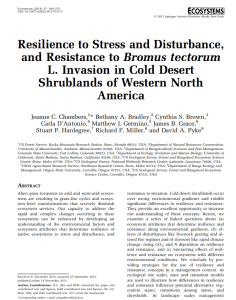Resilience and Resistance - A Collection of Resources
View the infographic.
View the Forest Service Bulletin summary.
View a list of information and tools for applying these concepts.
View the executive summary.
The Science Framework for Conservation and Restoration of the Sagebrush Biome is a two-part guide to managing sagebrush ecosystems in the West and was developed by an extensive interagency team of scientists and managers. It uses the concepts of resilience to disturbance (ability to recover) and resistance to invasive annual grasses across three geographic scales (sagebrush biome, ecoregions, and local sites) to prioritize conservation and restoration actions in areas where they are likely to have the greatest benefits.
Part 1 provides the science basis and decision-support tools for prioritizing areas and strategies for management.
Part 2 focuses on management considerations and tradeoffs for applying the information in Part 1, including monitoring and adaptive management, climate adaptation, wildfire and vegetation management, nonnative invasive plant management, application of National Seed Strategy concepts, livestock grazing management, and wild horse and burro considerations.
View article.
In sagebrush ecosystems invasion of annual exotics and expansion of pinyon and juniper are altering fire regimes and resulting in large-scale ecosystem transformations. Management treatments aim to increase resilience to disturbance and enhance resistance to invasive species by reducing woody fuels and increasing native perennial herbaceous species. This study used Sagebrush Steppe Treatment Evaluation Project data to test predictions on effects of fire vs. mechanical treatments on resilience and resistance for three site types. Warm (mesic) WY Shrub and WY PJ sites had lower resistance to annual exotics than cool (frigid to cool frigid) Mtn PJ sites. In WY shrub, fire and sagebrush mowing had similar effects on shrub cover and, thus, on perennial native herbaceous and exotic cover. In WY PJ and Mtn PJ, effects were greater for fire than cut-and-leave treatments and with high tree cover in general because most woody vegetation was removed increasing resources for other functional groups. In WY shrub, about 20% pretreatment perennial native herb cover was necessary to prevent increases in exotics after treatment. Cooler and moister WY PJ and especially Mtn PJ were more resistant to annual exotics, but perennial native herb cover was still required for site recovery. We use our results to develop state and transition models that illustrate how resilience and resistance influence vegetation dynamics and management options.
View article.
On the Ground Emerging applications of ecosystem resilience and resistance concepts in sagebrush ecosystems allow managers to better predict and mitigate impacts of wildfire and invasive annual grasses. Widely available soil survey information can be harnessed to spatially depict and evaluate relative resilience and resistance from regional to site scales. New products and tools illustrate how managers can use soils data to inform rapid risk assessments, determine appropriate management strategies, and prioritize resources to maintain and restore functioning sagebrush ecosystems.
View field guide.
This field guide provides a framework for rapidly evaluating post-fire resilience to disturbance, or recovery potential, and resistance to invasive annual grasses, and for determining the need and suitability of the burned area for seeding. The framework identifies six primary components that largely determine resilience to disturbance, resistance to invasive grasses, and potential successional pathways following wildfire, as well as the information sources and tools needed to evaluate each component.
The components are: (1) characteristics of the ecological site; (2) vegetation composition and structure prior to the wildfire; (3) fire severity; (4) post-wildfire weather; (5) post-wildfire management, especially grazing; and (6) monitoring and adaptive management.
The tools provided are: (1) a conceptual model of the key components that largely determine resilience to disturbance and resistance to invasive annual grasses of the burn area, (2) a guide to evaluate post-wildfire severity, (3) indicators to estimate pre-wildfire plant composition and structure if not known, and (4) an evaluation score sheet to rate an area’s potential post-wildfire resilience to disturbance, resistance to invasive annual grasses and, thus, the need for seeding and probability of success.
View field guide.
This field guide identifies seven primary components that largely determine resilience to disturbance, as well as resistance to invasive grasses and plant succession following treatment of areas of concern. An evaluation score sheet is included for rating resilience to disturbance and resistance to invasive annual grasses and the probability of seeding success.
View report.
This report provides a strategic approach for conservation of sagebrush ecosystems and greater sage-grouse that focuses specifically on habitat threats caused by invasive annual grasses and altered fire regimes. It uses information on (1) factors that influence sagebrush ecosystem resilience to disturbance and resistance to invasive annual grasses and (2) distribution, relative abundance, and persistence of sage-grouse populations to develop management strategies at both landscape and site scales.
View review.
This review examines the effects of disturbances, such as grazing, and changes in climate on resilience and resistance of cold desert shrublands that span temperature and precipitation gradients across the western United States. It demonstrates how to use information about cold desert resilience and resistance to help manage this ecosystem and describes the benefits of using protection, prevention, restoration, and monitoring strategies to determine priority management areas and appropriate management actions.








